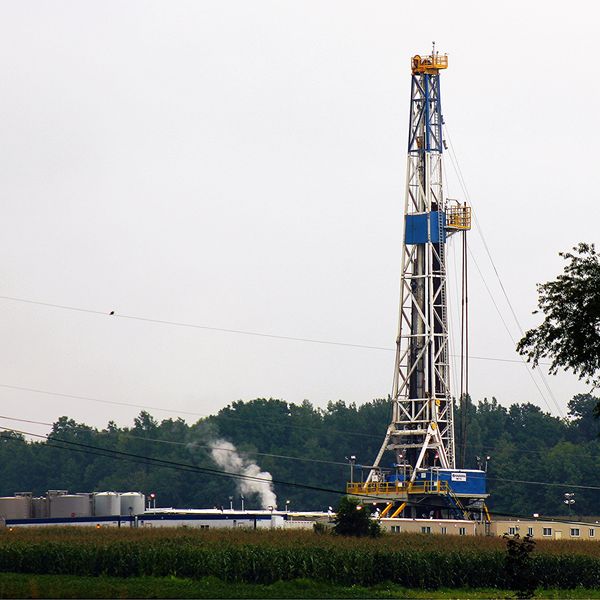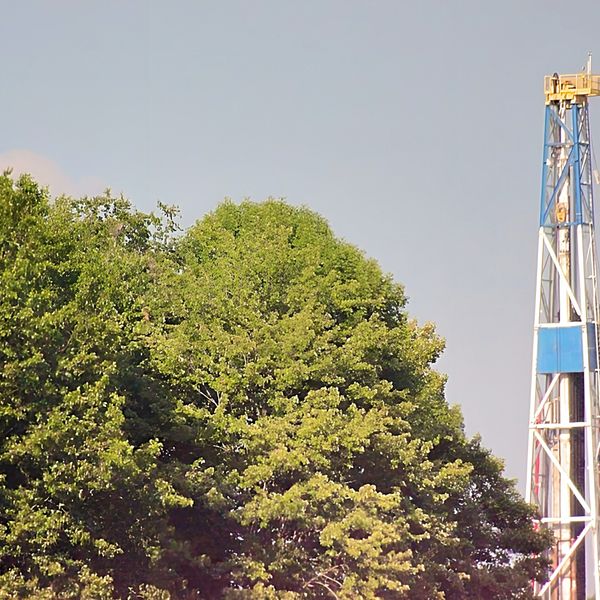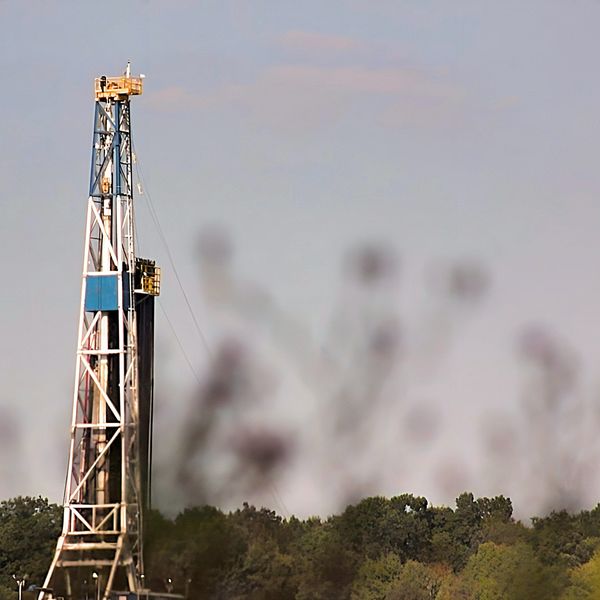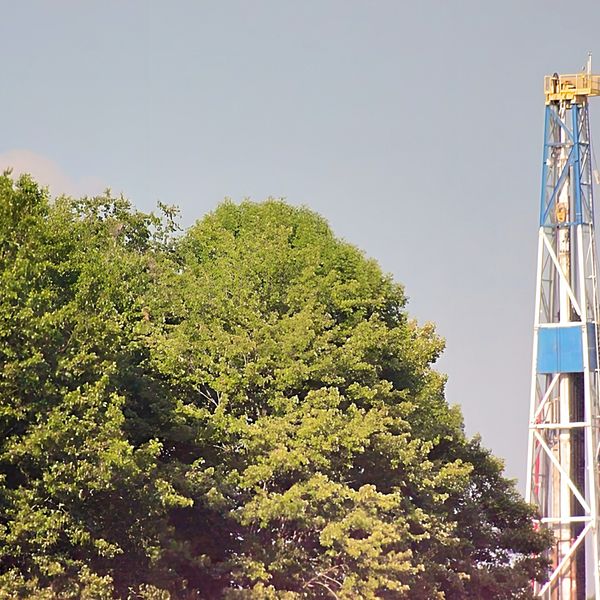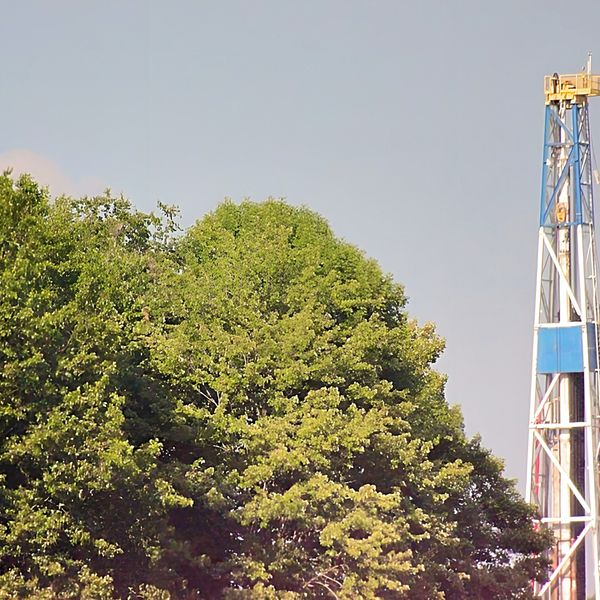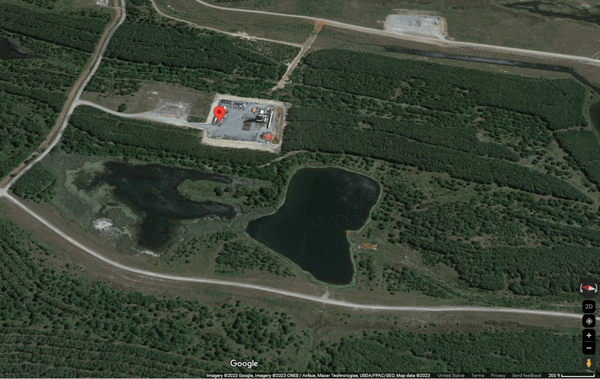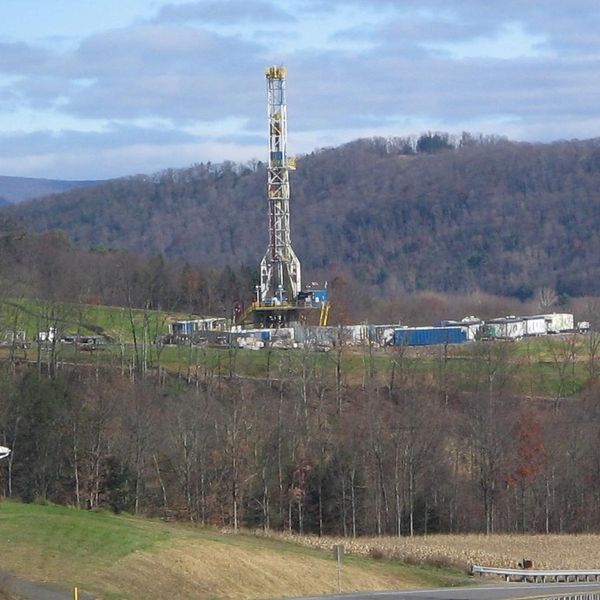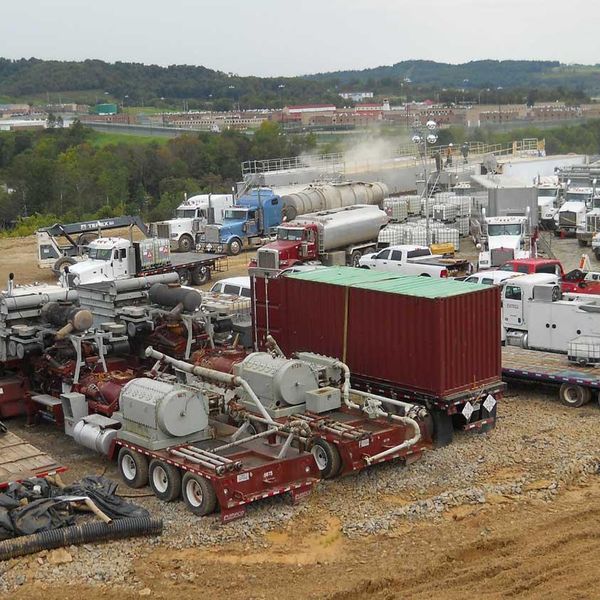This is part 2 of our 4-part series, "Fractured," an investigation of fracking chemicals in the air, water, and people of western Pennsylvania.
WASHINGTON COUNTY, Pa.—In the spring of 2019, after years worrying about exposures from a fracking well about a half mile from her grandkids' school, Jane Worthington decided to move them to another school district.
Her granddaughter Lexy* had been sick on and off for years with mysterious symptoms, and Jane believed air pollution from the fracking well was to blame. She was embroiled in a legal battle aimed at stopping another well from being drilled near the school. She felt speaking out had turned the community against them.
"It seemed like practically everyone in the district had leased their mineral rights," Jane told EHN (EHN). "We couldn't get anywhere with the school board, and it seemed like they all had a reason to want us to just shut up and go away."
The social strain combined with her granddaughter's illness was enough to make her want to leave.
Money was tight for Jane, who is a single caregiver, but she found a deal on a foreclosure in another school district.
The house, white with sage green shutters, sat on a quiet residential street. It was a bit of a fixer-upper, but she didn't mind the work—she just wanted a safe, comfortable home for her grandchildren, Lexy and Damien, who she'd raised since they were babies. At the time, Lexy was 15-years old and Damien was 13.
The kids fell in love with the house. There were still fracking wells nearby—they're virtually impossible to avoid in Washington County—but there were none within a mile of the school, and they didn't see any new wells being drilled close to the house.
Soon after moving in, though, they learned that their new home was within a mile and a half of a well pad with six wells already in production (meaning no longer being "fracked" or drilled, but producing natural gas and oil), and less than a half mile away from a large metal casting facility. An EHN analysis of the air and water at their new home, along with urine samples from the family, suggest they're being exposed to higher-than-average levels of many of the chemicals they were concerned about at their old house.
"We don't seem to be able to get away from this," Jane said.
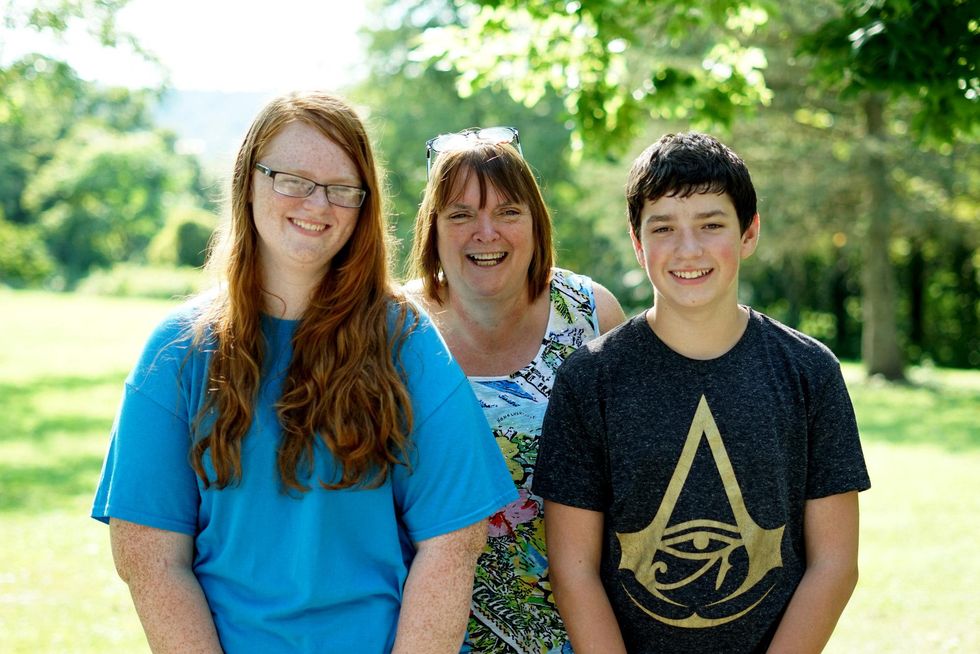
Lexy, Jane Worthington and Damien. (Credit: Connor Mulvaney for Environmental Health News)
In 2019, EHN collected urine samples, along with air and water samples, from five families in southwestern Pennsylvania and had them analyzed for chemicals associated with fracking.
Read about how we conducted our study
Jane and her grandchildren were one of the five families we studied. We collected a total of nine urine samples from the family over a 5-week period and found 18 chemicals known to be commonly emitted from fracking sites in one or more samples, including benzene, toluene, naphthalene, and lesser-known compounds—all of which are linked to negative health impacts including respiratory and gastrointestinal problems, skin and eye irritation, organ damage, reproductive harm, and increased cancer risk.
Some chemical exposures aren't detectable in urine if the body has already processed them, so we also looked for breakdown products, or biomarkers, for harmful chemicals. Some of these biomarkers show up when people consume certain foods or beverages, so to determine whether the levels we saw in Pennsylvania families were normal, we compared them against those seen in the average American using U.S. Centers for Disease Control and Prevention's (CDC's) National Health and Nutrition Examination Survey.
We found that urine samples for Jane and her grandkids contained biomarkers for fracking chemicals at levels higher than the U.S. 95th percentile—the value that 95 percent of Americans fall below, according to that CDC data.
All of the family's samples exceeded the U.S. 95th percentile for mandelic acid, a biomarker for ethylbenzene and styrene. More than half of the family's samples exceeded the U.S. 95th percentile for phenylglyoxylic acid, another biomarker for ethylbenzene and styrene, and for trans, trans-muconic acid, a biomarker for benzene. A third of the family's samples exceeded the 95th percentile for hippuric acid, a biomarker for toluene.

The Worthington family's new home. (Credit: Kristina Marusic for Environmental Health News)
Exposure to these compounds is linked to eye, skin, respiratory and gastrointestinal irritation; neurological, immune, kidney, cardiovascular, blood, and developmental disorders; hormone disruption; and increased cancer risk.
The family's urine samples also suggested that they had higher-than-average exposures to biomarkers for toluene and xylenes, which are linked to skin and eye irritation, drowsiness and dizziness, and central nervous system damage.
There's no way to know for certain whether the family's exposures came from fracking emissions. We visited Jane's home, had her complete an extensive survey about other possible sources of exposure, and recorded the family's activities around the time of our sampling and did not find other obvious explanations, though the metal casting facility near Jane's new home could also contribute to these exposures.
The exposures confirm Jane's worst fears—that the children she's tasked with protecting are exposed to harmful chemicals simply because of where they live. But the impacts run deeper. The family seemingly cannot escape the effects of an industry that wields tremendous power in the state and is allowed to operate within 500 feet of schools and homes housing children and other vulnerable residents. Researchers warn the impacts extend to the more out-of-sight aspects of health—people's sleep, their social network, and their overall mental well being.
"I just wish there was more awareness that it really is dangerous for every family that lives here," Jane said. "It isn't as safe as we tend to want to make ourselves feel. This is proof."
Exposed

A fracking well pad in southwestern Pennsylvania. (Credit: Ted Auch, FracTracker Alliance, 2015)
When she was in third grade, Lexy became very sick—she developed unusual rashes and had bouts of vomiting. She also developed asthma and started having severe nose bleeds.
After years of unknowns, Lexy's doctor noticed abnormalities in her growth plates, which led him to believe that her symptoms could be the result of a toxic exposure. A toxicologist found that Lexy had been exposed to benzene, a volatile organic compound (VOC). Because neither her brother nor grandmother were sick—and, seemingly, no other kids at her school—her doctor said she likely had a higher than average sensitivity to benzene.
Benzene is found in tobacco smoke, wood smoke, vehicle exhaust, and industrial emissions. It's also emitted into the air during both fracking and conventional oil and gas extraction, and is often found in fracking wastewater. Research has found that some workers at fracking sites are regularly exposed to high levels of benzene. Exposure is linked to cancer, organ damage with repeat exposure, fertility issues, skin and eye irritation, drowsiness and dizziness.
Despite having moved to a new neighborhood and a new school district, the levels of trans, trans-muconic acid—a biomarker for benzene—measured in all nine urine samples EHN collected from Jane Worthington and her grandchildren exceeded the U.S. median.
Two agencies—the American Conference of Governmental Industrial Hygienists and its German equivalent, the DFG (Deutsche Forschungsgemeinschaft)— established reference values that reflect people's typical background level exposure for trans, trans-muconic acid. The levels of trans, trans-muconic acid measured in five of the nine urine samples EHN collected from Jane Worthington and her grandchildren over a 5-week period exceeded both of those reference values by up to 11-fold.**
While Jane has frequently fretted over air emissions, she didn't previously worry about their water. At both their old home and their new one they used the local municipal service provided by Pennsylvania American Water, and at both houses the family consumed unfiltered tap water.
"I've always assumed they'd take care of making sure it's safe," Jane said.
We found benzene in the water at all three locations we sampled at Jane's house—the kitchen tap, the bathtub faucet, and the outdoor hose spigot. The highest level was in the outdoor hose spigot, which contained benzene at a level of 3.46 parts per billion. This was the highest level of benzene detected in the five households in our study.
Both the U.S. Environmental Protection Agency (EPA) and the Pennsylvania Department of Environmental Protection (DEP) have a maximum legal threshold of 5 parts per billion for benzene in drinking water, but the EPA has set a goal of no detectable benzene in drinking water because it can cause leukemia.
The levels of contaminants detected in different faucets at the same house can vary for a number of reasons, Chris Kassotis, an endocrine toxicologist and assistant professor at Wayne State University's Institute of Environmental Health Sciences, who has researched water quality extensively, told EHN. He explained that after water enters the home, it sometimes sits in pipes or tanks where it can pick up additional contaminants, and it sometimes travels through filtration systems that remove contaminants.
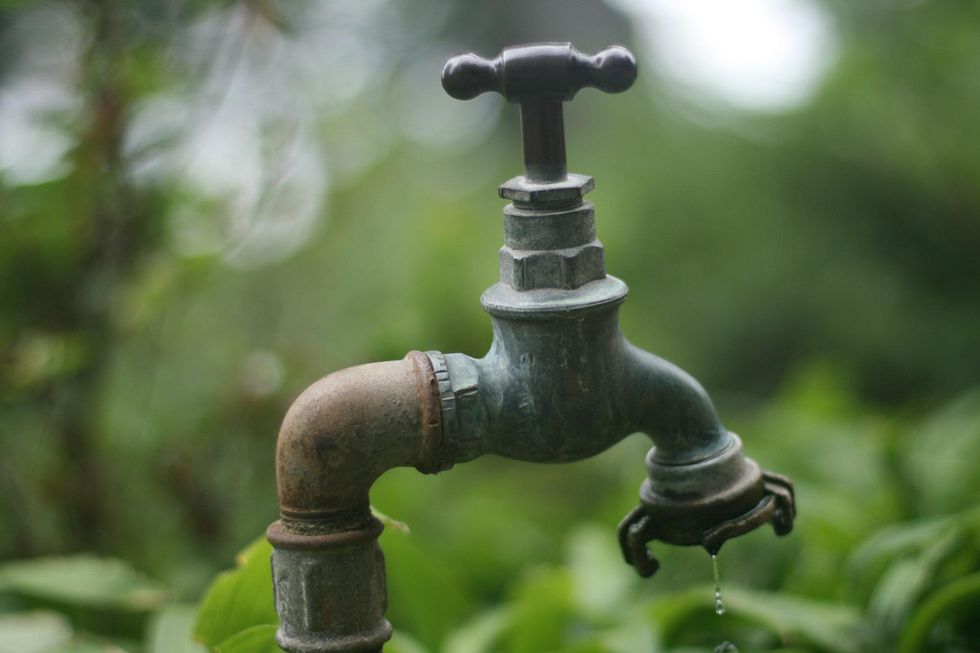
"I've always assumed they'd take care of making sure it's safe," Jane said of her water. (Credit: Kelbv/Flickr)
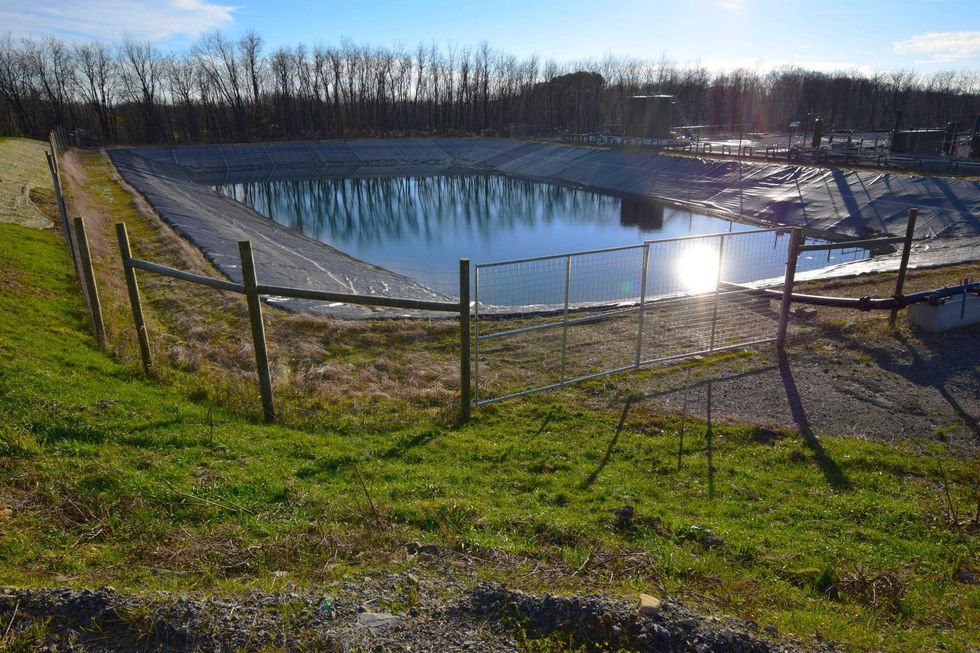
A fracking wastewater pond in southwestern Pennsylvania. (Credit: Ted Auch, FracTracker Alliance, 2015)
"Either way," Kassotis explained, "outside samples from a hose spigot are usually more reflective of what's coming from the water authority or groundwater in your region."
A spokesperson for Pennsylvania American Water who reviewed our findings told EHN in an emailed statement, "We follow a thorough sampling regimen as required by the Pennsylvania Department of Environmental Protection. Our monitoring continues to determine that levels of benzene are non-detectable."
Lauren Fraley, a spokesperson for the DEP, told EHN that, while they do not require action if benzene levels are below the 5 parts per billion threshold, levels at or above 4 parts per billion would trigger quarterly monitoring and follow-up measures.
"I guess maybe this means we should start filtering our water since we know [Lexy] is so sensitive to benzene," Jane said.
The family's exposure to other compounds was higher than average, too. For example on August 5, 2019, a urine sample from Jane Worthington showed a level of phenylglyoxylic acid, a breakdown product of ethylbenzene and styrene, more than 17 times as high as that of the average cigarette smoker (Jane does not use any tobacco products).
On two of the three days when EHN collected urine samples from the family, they also wore personal air monitors for six to eight hours. Lexy's monitor recorded the highest levels of decanal, pentadecane, heptanal, n-octanal, and n-nonane seen among the 39 air samples EHN collected last summer on August 6, 2019—a day when she stayed home and her only activities were going for a walk and taking a nap.
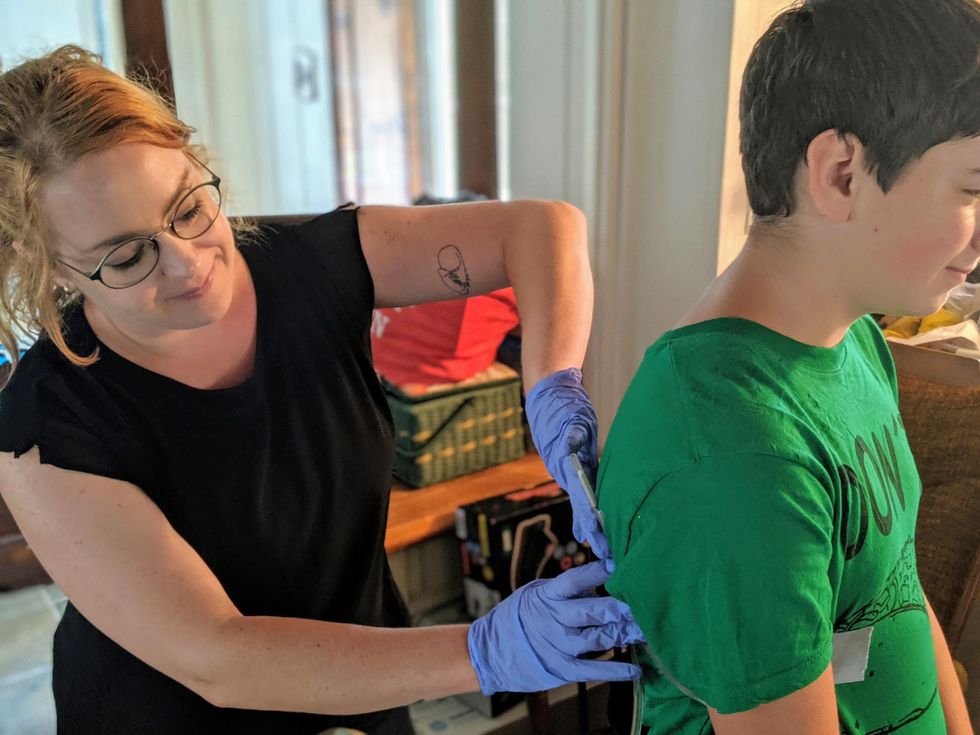
EHN reporter Kristina Marusic sets up an air monitor for Damien Schaffer. (Credit: Mason Secreti)
These chemicals can be found in household products, gasoline, and emissions from industrial and fracking facilities. Exposure to them is linked to a variety of negative health outcomes, including eye and skin irritation and respiratory problems.
Only a handful of these chemicals have regulatory limits, most of which pertain to short-term workplace exposures. Jane and her grandkids' air samples exceeded one regulatory threshold for three chemicals—the recommended limits on benzene, ethylbenzene, and naphthalene exposure set by the California Office of Environmental Health Hazard Assessment to minimize cancer risk.
Since her first episodes in elementary school, Lexy has had similar symptoms—rashes, nose bleeds, joint pain and stiffness, vomiting, and migraines—on and off, which Jane said have coincided with the times when active drilling or flaring (the burning off of excess natural gas) was happening at well pads near their home or near Lexy's school.

Lexy. (Credit: Connor Mulvaney for Environmental Health News)
Both active drilling and flaring are associated with higher levels of air pollution and more reported health effects than wells in the production phase.
The DEP has conducted air monitoring studies near fracking wells, but critical data gaps persist.
"When monitoring is done, it's often reported based on daily averages or weekly averages, or a short monitoring time that might be one day a week, and then that value is assigned to the whole week," Alison Steele, executive director of the Southwest Pennsylvania Environmental Health Project†, a community health advocacy group, told EHN.
"If you look at a 15 minute average readout you can actually see when there are intense spikes in emissions," she explained. "But if you take that out to a whole day as an average, you completely lose that information and it's not useful at all...you lose the opportunity to identify events that might be causing health impacts."
Jane witnessed the challenges related to air monitoring studies firsthand.
In response to public concern about the wells' proximity to Fort Cherry schools—much of which was raised due to Lexy's illness—Range Resources, the company that owns the well pad closest to the school, commissioned an air monitoring study in 2017. The company hired Gradient, a Boston-based environmental consulting firm that has previously published research aimed at discrediting the known links between exposure to asbestos, lead, and arsenic and negative health effects, and has had the scientific validity of its other air emissions research called into question after its test results contradicted EPA findings in Texas. The two-year study found that the wells near Fort Cherry schools "do not pose any acute or chronic health concerns," and that the data "showed no air quality impacts of potential health concern." But the Southwest Pennsylvania Environmental Health Project issued a public statement calling the report "highly flawed in its methodology, scope, and objectivity" in part because it was not set up to catch sporadic emissions.
Jane felt that the whole undertaking was disingenuous and unhelpful—and she felt both validated and left out when, in June of 2020, Range Resources pleaded "no contest" to charges of environmental crimes filed by the Pennsylvania Attorney General's office over its actions at two other well sites in Washington County.
Ostracized and alienated
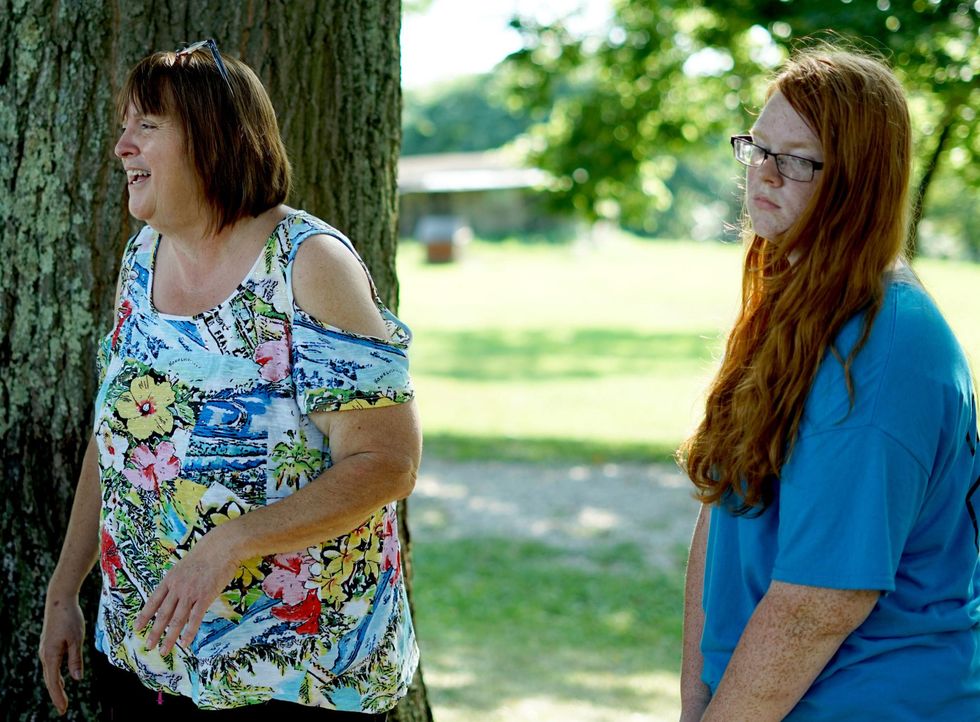
Jane Worthington, left, and her granddaughter Lexy. (Credit: Connor Mulvaney for Environmental Health News)
For Jane, fracking seemed to split her community: Those who got jobs or made money from mineral leases, and those whose quality of life was damaged or loved ones got sick. Because their own kids weren't sick, many of Jane's neighbors refused to believe that what happened to Lexy could be related to fracking.
These issues have caused Lexy to experience depression and anxiety about her symptoms, about her alienation from classmates and community members who benefit from the industry, and about the feeling that the industry's impacts are inescapable.
At her old school, things got progressively worse after she became sick. On numerous occasions she got sick and vomited in front of classmates, which mortified her. She started wearing an air monitor that made loud noises when air pollution reached an unsafe level for her, which was embarrassing. Teachers and students would grill Lexy about her symptoms, implying—and sometimes saying outright—that she must be making it all up.
"A lot of kids would ask, 'If it's because of fracking, why aren't all of us sick like you?' Lexy said. "That really frustrates me, because I don't know the answer."
It wasn't just the kids—adults in the school district were also cruel. Jane said that at several public meetings they were shouted at, called liars, and told to leave town. She said that a few other parents quietly approached her to share stories about how their own children had also experienced mysterious health symptoms once fracking moved in, but that most were too afraid to speak up.
The family has been making trips to Harrisburg and Washington D.C. for more than eight years to plead with their representatives and other lawmakers to protect them. The kids have even spoken on the floor of the U.S. Senate.

Damien Shaffer. (Credit: Connor Mulvaney for Environmental Health News)
Damien, Lexy's easy-going half brother, told EHN, "We are feeling that people are starting to listen. Finally."
Lexy cut him off—"No," she said, "they really aren't. None of it does any good. It's not fair. I just want to be normal and have a normal life like other kids."
She isn't the only one feeling anxious and disempowered.
A 2017 literature review that looked at all available studies on the mental health impacts of fracking found that it's common for people in fracked communities to experience "worry, anxiety, and depression about lifestyle, health, safety, and financial security," and that "entire communities can experience collective trauma as a result of the boom/bust cycle that often occurs when industries impinge on community life."
And similar evidence keeps piling up:
- A 2018 study found that stress and depression are higher among Pennsylvanians who live near fracking wells.
- A 2020 study of a community in Denton, Texas, found increased stress, and animosity and tension between community members as a result of fracking.
- Another 2020 study that surveyed Colorado households found that uncertainty about environmental and health risks of fracking and feelings of political powerlessness led to chronic stress and depression.
The Southwest Pennsylvania Environmental Health Project has been tracking symptoms experienced by people who live near fracking wells in Pennsylvania for the last decade. In the spring of 2020 they published a paper on data collected from 2012-2017 that documented 17 symptoms, which increased in severity the closer people lived to a higher volume of fracking wells. The top three were difficulty sleeping, anxiety/worry, and depressed mood.
"One community member told me that since fracking moved in, they now understood why sleep deprivation is used as a torture technique," Hannah Blinn, a former environmental health educator and fellow at the organization and lead author of the 2020 study, told EHN. "That kind of stress creates its own health impacts. When we document that someone has a headache, for example, is that because of a chemical exposure or because they haven't slept and their neighbors don't trust them anymore?"
Proponents of the industry's economic benefits are quick to point out that being jobless also impacts people's mental health. Democratic Pennsylvania State Representative Robert Matzie has been a vocal supporter of the petrochemical plant being built by Shell adjacent to his district in Beaver County (33 miles northwest of Pittsburgh), which will convert ethane from an estimated 1,000 new fracked wells per year into plastic.
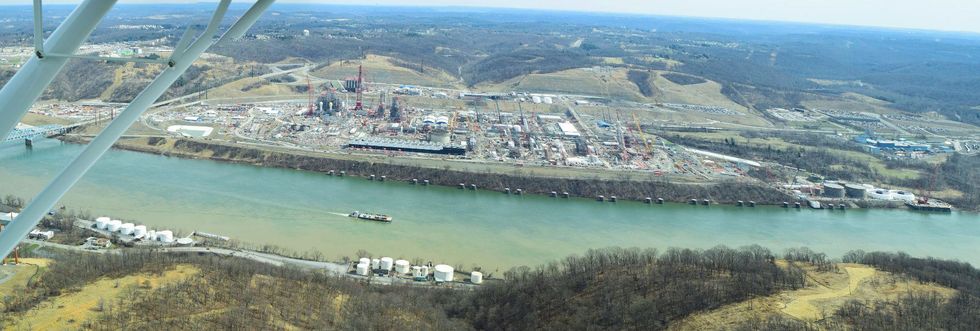
Aerial view of the construction site of the Shell ethane cracker in Beaver County, Pennsylvania.(Credit: Ted Auch, FracTracker Alliance, 2019)
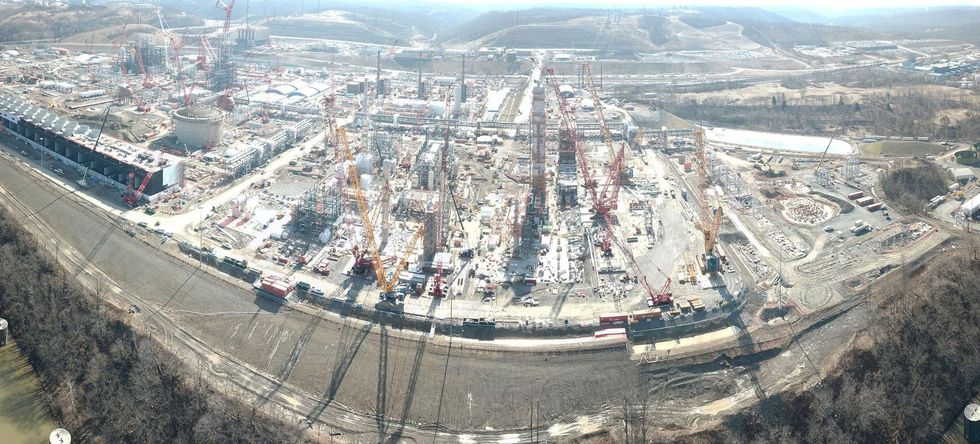
Aerial view of the construction site of the Shell ethane cracker in Beaver County, Pennsylvania. (Credit: Ted Auch, FracTracker Alliance, 2019)
He recalled watching the demise of the steel industry and watching people struggle to adapt.
"I went to community college for my first two years in the 80s, and I remember having classes with guys in their 40s or 50s who'd been working in a steel mill since the day they left high school struggling with their course load and seeing any other future for themselves," he told EHN. He worries that without a comprehensive transition plan, something similar could occur if the oil and gas industry left the region, and he sees the petrochemical industry as an opportunity to help community members who are struggling.
"I know a number of people in my community, including my neighbor who is an operating engineer and a steamfitter down the street from me, who are doing very well as a result of construction of that plant," Matzie said. "While those jobs are temporary, these people have been able to keep working and paying the bills during a global pandemic, which is a big deal and means a whole lot to them."
Blinn pointed out that feelings of division and alienation can be experienced by community members who benefit from the industry, too.
"People who have jobs with oil and gas or who lease their land and are getting yelled at in community meetings or by their neighbors who fear for their health are often distressed too," she said. "They feel like they were just trying to take care of their families and now everyone is mad at them for it. It really can cause rifts across the entire community."
"Safe" distances

Flaring at a compressor station in Ohio. (Credit: Ted Auch, FracTracker Alliance, 2018)
Jane's primary concern with the Fort Cherry School District was how close the wells were to the building where her granddaughter spent her days.
In Pennsylvania, unless municipalities set more stringent regulations, horizontally drilled well pads are required to be at least 500 feet away from the nearest occupied building—including homes, schools, and daycares.
Private property owners can waive this requirement, so wells are sometimes even closer to homes and businesses in the state. There are no federal regulations about how far fracking wells should be from schools, so states and municipalities are left with a patchwork of different protections. According to the Southwest Pennsylvania Environmental Health Project, the closest well to a school in Pennsylvania is in Butler County, about 85 miles north of Washington County, where a well pad sits about 633 feet from Summit Township Elementary School.
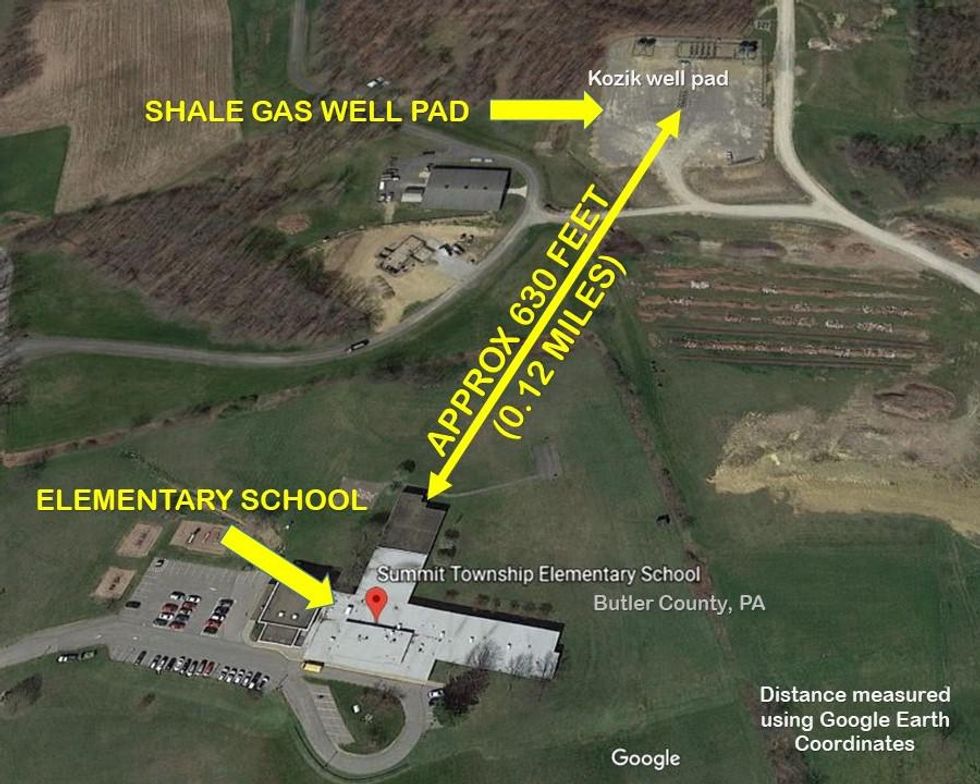
Credit: (Southwest PA Environmental Health Project/Google Maps)
Proximity to fracking wells has been linked to higher cases of low birth weights, childhood cancers, skin problems, asthma exacerbations, and migraines and fatigue in hundreds of studies since the beginning of the boom. The state of New York banned fracking in 2014 on the basis of 400 studies showing potential health harms from the industry. As of August 2020, there were 2,015 studies indicating harm—about five times the amount that prompted New York to ban the practice—according to a literature review conducted by the health advocacy groups Physicians for Social Responsibility and Concerned Health Professionals of New York.
"What makes fracking different from any other industry I've studied in public health is that there's no industrial zone," Sandra Steingraber, a professor of Environmental Studies and Sciences at Ithaca College and co-author of the 2020 literature review, told EHN. "It's taking place literally in our backyards, and unfortunately some of the best evidence for both polluting emissions and emerging health crises is coming out of southwestern Pennsylvania."
Children are more vulnerable to harmful effects from environmental pollutants because they breathe about four times more air and drink more water pound for pound than adults, and their bodies—not yet fully developed— are less able to filter out pollutants. This makes them more vulnerable to short-term health effects like asthma and stomach problems, and also to long-term health effects like heart disease and cancer.
"The thinking is that chemicals get into cells in human bodies and cause changes to genes," Dr. Philip Landrigan, pediatrician, epidemiologist and director of the Global Public Health Program and the Global Observatory on Pollution and Health at Boston College, told EHN. "A single hit on a gene won't typically cause cancer...most cancers evolve over a span of many years with multiple hits accumulating over time. If it takes five or six hits to a gene to produce cancer and a child goes through the first two or three hits in early childhood, that child is then much closer to developing cancer once they become an adult."
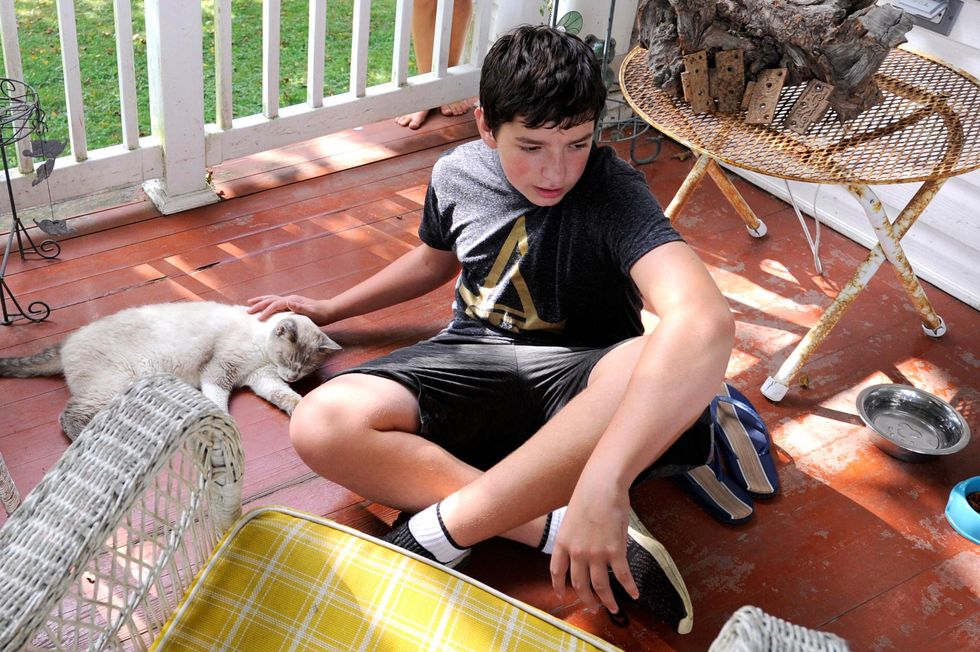
Damien Shaffer. (Credit: Connor Mulvaney for Environmental Health News)
Researchers also warn that many of the chemicals emitted during fracking can be harmful at lower levels than current regulations account for—even the most stringent regulations on the books.
At least 21 common fracking chemicals (including many of the ones we found) are also endocrine disruptors, meaning they mimic the body's hormones. This can lead to numerous negative impacts on reproductive, respiratory, metabolic and immune systems and children's development.
Carol Kwiatkowski, a professor at North Carolina State University and former executive director of the nonprofit research institution The Endocrine Disruption Exchange, warned that current regulations don't take this into account because many of these effects occur at very low levels of exposure, which traditional toxicology testing doesn't measure.
She explained that generally when scientists see adverse health effects at a certain level, they keep dropping the exposure lower and lower until they no longer see those effects. Then they set an exposure limit a hundred or a thousand times lower than that.
"They think they're being extra cautious," Kwiatkowski told EHN, "setting our safe exposure level so much lower than where they saw effects. But they never test that level. It's just an assumption that it will be safe."
Ultimately, Kwiatkowski said, this means that being exposed to some of these pollutants at any level isn't safe—even if they're seen at levels well below existing legal thresholds.
A 2020 study found that doubling the current Pennsylvania setback distance of 500 feet to 1,000 feet (a little less than a quarter of a mile) would reduce the number of people who are exposed to emissions greater than the EPA's recommended annual limit for particulate matter pollution by 86 percent.

A drilling rig in Washington County, Pennsylvania. (Credit: Ted Auch, FracTracker Alliance, 2016)
"The science does not say that any distance is safe," Alison Steele, executive director of the Southwest Pennsylvania Environmental Health Project, told EHN. Her organization published a 2018 study that recommended a minimum setback of 0.25 miles, or about 1,320 feet. They're among a number of groups that have unsuccessfully pushed for these changes at the state level.
In the summer of 2020, a grand jury report on fracking from the office of Pennsylvania Attorney General Josh Shapiro, which concluded that current regulations aren't protective of residents' health, recommended wells be placed at least 5,000 feet (just shy of a mile) from schools.
"We have a profound gap between the 'clean air and pure water' promised in our Constitution and the reality that too many Pennsylvanians live with every day," Shapiro told EHN. "It is up to us to close that gap to protect the health and safety of every Pennsylvanian."
A spokesperson for Attorney General Shapiro who reviewed highlights from EHN's investigation said our findings are in line with those of the grand jury, and "serve to reinforce the stories that the various Pennsylvania homeowners have been telling for over 14 years now," which suggest fracking is occurring too close to residents.
Many states have similar—or even less stringent—setback regulations. Colorado is a notable exception.
In 2019 the Colorado Department of Public Health and Environment released a 380-page report on the potential health impacts of oil and gas operations, which found that air pollution from wells could impact human health within a 2,000-foot radius.

A 2015 fracking protest outside former Colorado Governor John Hickenlooper's home (Credit: John Duffy/Flickr)
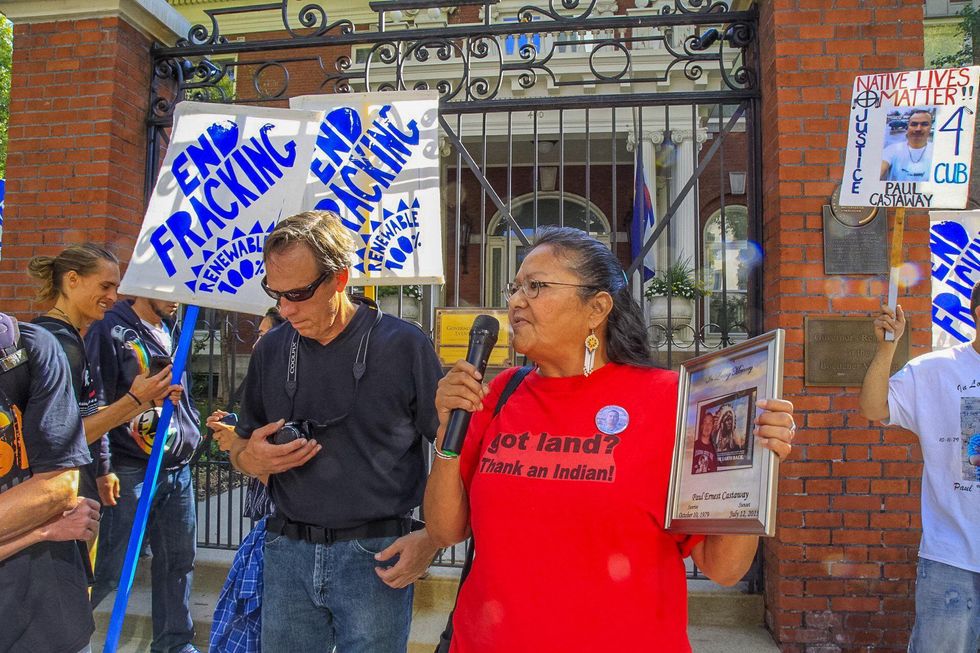
A 2015 fracking protest outside former Colorado Governor John Hickenlooper's home. (Credit: John Duffy/flickr)
In November 2020, following more than 180 hours of public hearings with industry groups, scientific researchers, public health officials, homeowners associations and environmental advocates, the newly revamped Colorado Oil and Gas Conservation Commission announced numerous new oil and gas regulations—many of which are the strongest in the country—including a 2,000-foot setback distance (with an option for well operators to apply for exceptions).
"By taking a more cautious approach through increased setback distances, we're reducing the likelihood of community exposure to hazardous air pollutants and other emissions," John Putnam, former director of environmental programs at the Colorado Department of Public Health and Environment, told EHN. (Putnam recently left the Colorado Department of Public Health and Environment to take a position as Deputy General Counsel for the U.S. Department of Transportation.)
In Pennsylvania, some lawmakers believe current setback regulations are adequate, while others are pushing for additional regulations.
"Nobody has complained to me about a health issue," Republican Pennsylvania Senator Gene Yaw, who chairs the state Senate Environmental Resources and Energy Committee, told EHN. "The purpose of some of the things that have been tried in Pennsylvania regarding setbacks has just been to eliminate the oil and gas industry entirely. I don't know of any significant problem areas that would merit changing setbacks."
When asked about the grand jury report's findings on the need for greater setbacks Yaw said, "The Attorney General's report is truly embarrassing. He relied on witnesses who have been preaching the same story for the past 12 years… It's embarrassing that he fell for it."

Pennsylvania State Capitol (Kumar Appaiah/flickr)
Matzie, the Democratic Pennsylvania State Representative who supports the Shell Ethane Cracker—which will require ethane from an estimated 1,000 new fracked wells per year—told EHN he doesn't believe current fracking regulations are adequate to protect the health of Pennsylvanians.
"That's one thing that's been hard to reconcile and hard to explain to the general public," Matzie said. "I support the plant and the downstream jobs it's expected to create, but at the same time we've lacked as policymakers to ensure that we have adequate safeguards in place for physical fracking wells. It's a tough balance."
He said he voted against the state's controversial Act 13, which originally allowed the state to override local municipality regulations on the industry like greater setback rules—one of several portions of the law that were eventually overturned by the Pennsylvania Supreme Court. Matzie also unsuccessfully introduced legislation that would create greater setbacks from freshwater sources in the state.
"Implementing new oil and gas regulations isn't necessarily at the top of the list of things to get done by Republican-controlled legislatures," he said.
Ongoing anxieties
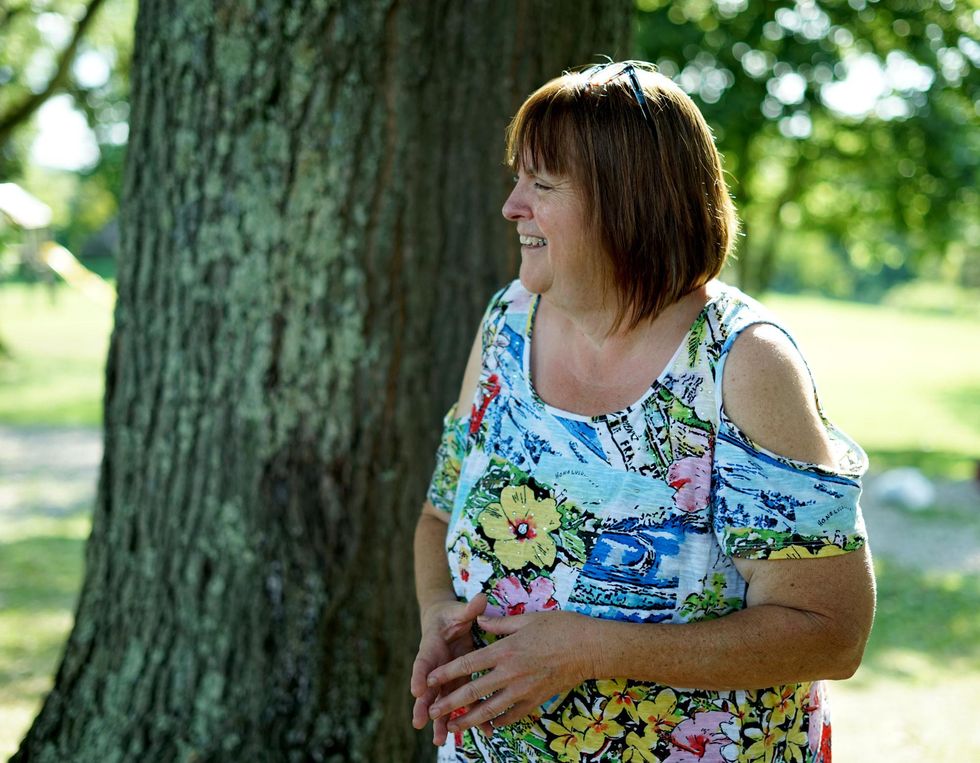
Jane Worthington. (Credit: Connor Mulvaney for Environmental Health News)
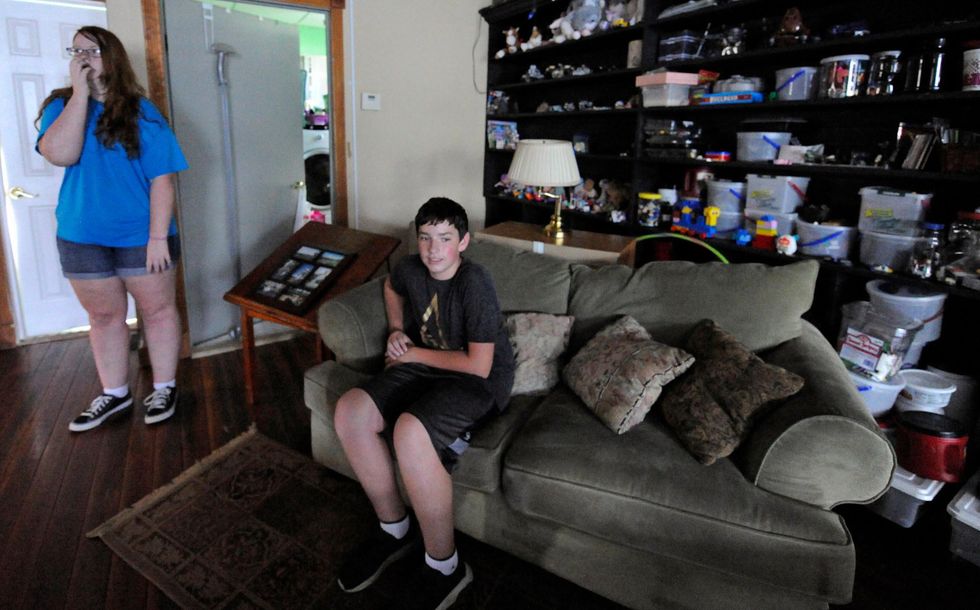
Lexy and Damien. (Credit: Connor Mulvaney for Environmental Health News)
The new school district Jane and her family just moved to is Canon-McMillan. This school district is home to multiple cases of Ewing sarcoma, a rare childhood cancer, which many residents fear are related to fracking. So far no link has been found, but a Pennsylvania Department of Health investigation is ongoing.
After learning the results of our study, Jane and Lexy both expressed concern over their continued exposure.
"I don't know why Lexy is so much more affected by this than other kids," Jane said, "but she shouldn't have to worry about her sensitivity—because there shouldn't be benzene in our water or our air where we live everyday."
Since the move, Lexy has had a few nosebleeds, but otherwise her symptoms have been better. She's no longer known as "the sick girl" at school, she's made new friends, and she feels more comfortable with her new teachers and school administrators. But she still experiences fear and anxiety.
"Every time I go near that factory near the trail my stomach hurts and I feel like I can't breathe," she said, referring to the metal casting facility near her new home.
"I'm afraid it could just happen again, and we'll have to go through the same process over and over again," she said. "I'm so sick of being sick and of all the testing, and of never actually knowing what's wrong with me."
Lexy sees a counselor every week and is on medication for her anxiety. "But," she said, "I don't really talk about fracking or these exposures in therapy. It doesn't really help to talk about it."
"What would help?" asked Jane.
"For it to stop," Lexy said. "For all of it to just stop."
Frequently Asked Questions about Fractured: What to do, who to call, how to push for change.
Have you been impacted by fracking? We want to hear from you. Fill out our fracking impact survey and we'll be in touch.
In part 3 of the series: The disconnect between fracking communities and the regulators tasked with protecting them.
This story was fact-checked by Dani Leviss.
* Editor's note: Lexy is a pseudonym
**Editor's note: This story has been updated to add context for the trans, trans-muconic acid reference levels.
† The Southwest Pennsylvania Environmental Health Project and EHN both receive funding from the Heinz Endowments
- Pollution’s mental toll: How air, water and climate pollution shape our mental health - EHN ›
- How contaminated water contributes to mental illness - EHN ›
- Pollution’s mental toll: How air, water and climate pollution shape our mental health - EHN ›
- How contaminated water contributes to mental illness ›
- Fracking risks for childhood cancer, low birth weights, asthma - EHN ›


















